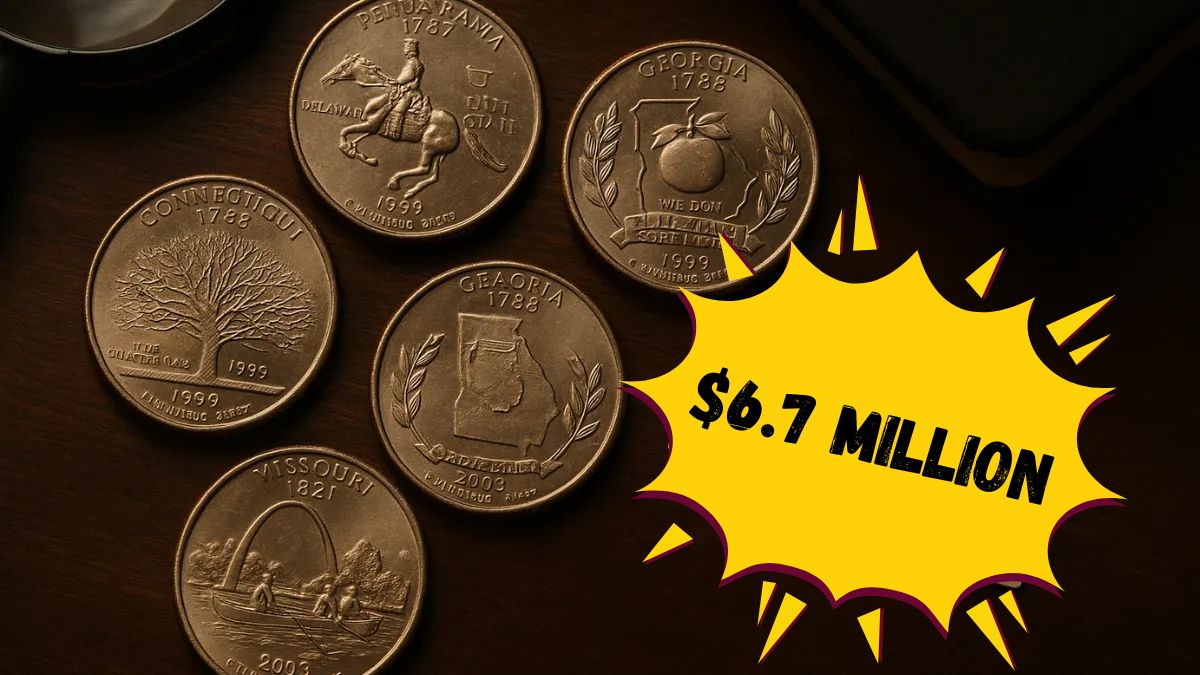If you’ve been holding onto your state quarters, now might be the perfect time to check your collection. Some of these coins, especially those with unique errors or in pristine condition, have fetched impressive sums at auctions.
Here’s a detailed look at five rare state quarters that have garnered significant attention and value in the numismatic community.
1. 2004-D Wisconsin State Quarter – Extra Leaf Varieties
The 2004-D Wisconsin quarter is renowned for its unique error: an extra leaf on the corn stalk. There are two distinct varieties: the “Extra Leaf High” and “Extra Leaf Low”. These anomalies were the result of die gouges during the minting process.
- Circulated Value: $50–$150
- Uncirculated Value: $250–$500
- Certified MS-65+: Up to $1,200
These coins were released into general circulation, making it possible for collectors to find them in everyday transactions.
2. 2005-P Minnesota State Quarter – Extra Tree Error
The 2005-P Minnesota quarter features an error known as the “Extra Tree” variety. This error manifests as an additional tree near the existing ones, caused by die damage.
- Circulated Value: $75–$200
- Uncirculated Value: $300–$600
- Certified MS-65+: Up to $1,500
The scarcity of this error, combined with its distinct appearance, makes it a sought-after piece among collectors.
3. 1999-P Delaware State Quarter – Spitting Horse Variety
As the first coin in the State Quarters Program, the 1999-P Delaware quarter holds historical significance. A notable error, dubbed the “Spitting Horse”, features a die crack that appears to emanate from the horse’s mouth.
- Circulated Value: $20–$50
- Uncirculated Value: $40–$100
- Certified MS-65+: Up to $300
This whimsical error adds a unique charm to the coin, increasing its desirability.
4. 2000-P South Carolina State Quarter – High-Grade Specimens
While not an error coin, the 2000-P South Carolina quarter has seen high auction prices due to its condition. Coins graded MS69 have fetched impressive sums.
- Certified MS69: Up to $3,525
The rarity of such high-grade specimens makes them valuable to collectors seeking pristine examples.
5. 2000-P Massachusetts State Quarter – High-Grade Specimens
Similar to the South Carolina quarter, the 2000-P Massachusetts quarter has achieved notable auction results when in top condition.
- Certified MS69: Up to $3,760
Collectors place a premium on coins that have been preserved in exceptional condition, making these high-grade quarters particularly valuable.
Summary Table of Rare State Quarters
| Year | State | Variety/Error | Circulated Value | Uncirculated Value | Certified MS-65+ Value |
|---|---|---|---|---|---|
| 2004 | Wisconsin | Extra Leaf High/Low | $50–$150 | $250–$500 | Up to $1,200 |
| 2005 | Minnesota | Extra Tree | $75–$200 | $300–$600 | Up to $1,500 |
| 1999 | Delaware | Spitting Horse | $20–$50 | $40–$100 | Up to $300 |
| 2000 | South Carolina | High-Grade Specimen | N/A | N/A | Up to $3,525 |
| 2000 | Massachusetts | High-Grade Specimen | N/A | N/A | Up to $3,760 |
While most state quarters are worth their face value, certain errors and high-grade specimens have captured the attention of collectors, leading to significant valuations.
Whether it’s the quirky “Spitting Horse” of Delaware or the pristine Massachusetts quarter, these coins highlight the fascinating world of numismatics. So, take a moment to inspect your change—you might just have a hidden treasure in your pocket.
FAQs
How can I determine if my state quarter is valuable?
Examine your coin for any unusual features or errors, such as extra designs or die cracks. Additionally, coins in exceptional condition (high grades) can be valuable. Consulting a professional coin grading service can provide an accurate assessment.
Where can I sell my rare state quarters?
Rare coins can be sold through reputable coin dealers, auction houses, or online platforms specializing in numismatics. Ensure you have your coin appraised and authenticated before selling.
Are all state quarters from 1999–2008 valuable?
Not all state quarters are valuable. Only those with specific errors, unique varieties, or in exceptional condition tend to fetch higher prices among collectors.
